 It can be seen in the hands of the Austro-Hungarian explorer, Count
László Ede Almásy in photographs dating to the early 1930’s. Almásy had
explored the Libyan Sahara where he discovered the famous cave
paintings. His life was covered in the Anthony Minghella film "The
English Patient" (click
on the photograph for enlarged view).
It can be seen in the hands of the Austro-Hungarian explorer, Count
László Ede Almásy in photographs dating to the early 1930’s. Almásy had
explored the Libyan Sahara where he discovered the famous cave
paintings. His life was covered in the Anthony Minghella film "The
English Patient" (click
on the photograph for enlarged view). The 1902 patent describes a wooden casing. As soon as 1906 a second
larger version was available. It had an aluminium case and a mirror.
The division was more precise (every 2° instead of only 5°). During
WW1, the case of the Army models was made of a Bakelite-type material
called Hartgummi
(hardened natural rubber, check Ebonite in Wikipedia) in the
documentation. Later produced models were made of aluminium. The basic
model called Spiegelmodell
1906 (mirror version) was later modified into Armeemodell 1910 II.
The version produced from 1913 on with markings in radium
paint was called "R".
The 1902 patent describes a wooden casing. As soon as 1906 a second
larger version was available. It had an aluminium case and a mirror.
The division was more precise (every 2° instead of only 5°). During
WW1, the case of the Army models was made of a Bakelite-type material
called Hartgummi
(hardened natural rubber, check Ebonite in Wikipedia) in the
documentation. Later produced models were made of aluminium. The basic
model called Spiegelmodell
1906 (mirror version) was later modified into Armeemodell 1910 II.
The version produced from 1913 on with markings in radium
paint was called "R".| The
first design (rectangular wooden case) was produced by Otto
A. GANSER (Vienna,
Austria) approximately in 1903. It was consistent with an
early manual (see Part
2 Documentation). The case was made of mahogany and larger than later
versions, the 60mm ruler was made of ivory. Moreover, it featured two
lateral recesses allowing a better grip of the bezel. The
marching course brass arrow pointed to the right. |
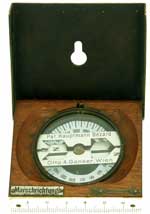 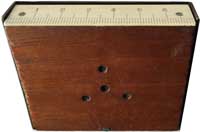 |
Markings on the magnetic needle's cut-out frame: Pat. Hauptmann Bézard (Patent captain Bézard) |
The next
version (1905) existed both with a wooden case (consistent with the
patent but round on one side) and a metallic case. The divisions were
printed on cardboard or
engraved on the aluminum case bottom.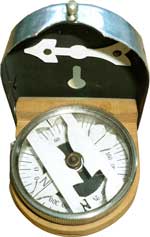 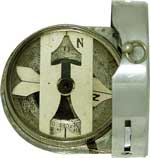 Technical Data (Small Model) - Dia.: 45mm - Case width: 52mm - Divisions: 5° on paper / 2° on metallic case In the metallic version, the figures were also engraved inverted (click on pict. above right for detail view) so that they could be read in a mirror which was not installed on all items. See a descr. published in the 1907 catalog of the French retailer for metallic products ('fire arms and bikes') MANUFRANCE. - Arrow system: see further below - Weight: 37gr / 62 gr |
The
lids of the original model with the patent no. and a very small arrow
beside the word DIREKTION (resp. MARSCHDIREKTION on the one with
aluminum casing):
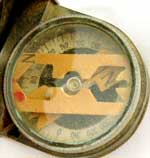 Pessler & Sohn (P.&S.) also built a version of the wooden case model See also further below: Imitations / Austria / Ganser |
In its
1907 catalogue, the French company Société
des Lunetiers (S-L) displayed two versions: plain wooden case
and aluminum case with a real glass mirror (!)  See also the Auricoste version without any patent mention - probably because of the specific WW1 situation.  At r.: The compass with a pendulum (P) for measuring elevation angles Technical Data (Large Model) Dia.: ... mm* Case width: ... mm* Divisions: 2° Weight: 75 gr * Dim. are probably identical to later models |
| The next development was
the Armeemodell 1910: |
|
While the slots on all models were plain straight openings, on the
small Model I S manufactured after the Second World War they terminated
at the base like gun sights. |
The slots on the UBK
(see further below)
featured in addition two horizontal wires used to aim at elevated
objects and measure their elevation angle together with the
clinometer. The offset between the sight line (through the slots) and the apparent position of the needle's point in relation to the divisions was a drawback because of the resulting parallax which Capt. Franz Winterer described thouroughly in a chap. of his book (see pic. at right) in which he compares the Bézard compass with his own. |
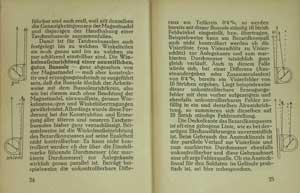 Picture : drawings in the margins in Der Militärische Gebrauch der Winterer Bussolen, 1936) |
Large model II |
Small model I
S
|
BÉZARD FLUID
|

| Small model with provisional MILS divisions |
  |
The marching course index was a tiny celluloid
tab with a red line. It was replaced later by a metallic tab. A degrees-mils conversion table (also a photograph) was placed In the lid. Signature on the table (also a photograph): "f. Schwab" |
Large model with
provisional MILS divisions
|
Several
years later, in its second manual, Gallinger (1933, p. 8, Fig. 3)
stated by way of addended (red label) that the graduation was also
available with the zero mark to North, due to numerous requests...  |
The
dial featured in the 1930's Radium-paint dots at 45 und 90 deg
on both sides of the N-S line (see also Winterer).  Dial with additional luminous marking at 45 and 90 deg. |
| SPECIAL
VERSIONS Between the 1913 version (above) and the simplified post WWI design (s. below: Clients BW / BGS) the graduation has evolved through several different designs. |
 Armeemodell I:
Armeemodell I:The graduation could be counter clockwise and the 6 numbers (multiple of 1000) indicated with 4 digits! |
 Armeemodell II: Armeemodell II: The number facing north could be doubled (6400 and zero). This compass featured on its lid the totally unusual drawing of a bow and arrow (link to picture). |
| EXPORT
VERSION (FRANCE) Divisions: 400 Gradians or Gons (see menu Miscell. / Divisions) |
 |
Specific signs: this version wears moreover the mention "Germany" i.e. it was probably made in the early 30s. The casing shows no marking or maker's name whatsoever (link to pic.). |
The declination could be
adjusted for local requirements. Under the capsule glass two
superimposed celluloid disks could be moved in relation to each other.
One bore the graduations and the other (situated underneath the first)
the luminous marks for the cardinal points, i.e. a line for magnetic
North and a circle for South. One placed the line opposite the local
value for magnetic North. However, this procedure was rather difficult:
One had to remove and then replace three tiny screws and a 10mm long,
tiny flexible pin in a groove, acting as a spring (not shown on the
picture st r.). Right: One of the three screw: |
Bézard Compass dismantled:
in the lower section, the two celluloid discs.
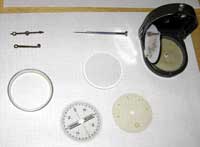 |
On the UBK III model realized from the 1930’s
correction for magnetic declination was easier and did not require the
dismantling of the compass: a small pin attached to a cord allowed the
locking of the lower disc by means of a hole situated on the mirror
hinge and then it was only necessary to turn the capsule in order to
set the rose to the correct value.
 Simplified adjustment for magnetic declination on compass UBK III Some instruments are marked D (for declination) |
| Jakubowski's
Version (made by GERLACH) A system allowing a precise setting of the magnetic declination was developed in 1933 by Olgierd Jakubowski (Warsaw, Polish patent no. 20963*). A disk with a sliding ruler at the capsule's base could be rotated by the declination's angular figure and locked with two screws. The sliding ruler would be then used like the East-West-bar of the original Bézard compass. This ruler also pushed the needle upwards when closing (transit lock). * German version available |
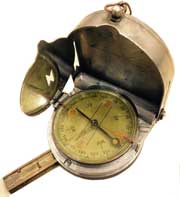 Pic. by courtesy of M. Ivanov (Click on image above for full descr. in GERLACH entry) |
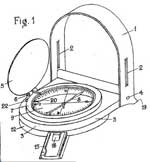 
|
| The early models had a round or oval loop fixed to a stem as on pocket watches. After World War II, this was replaced by a riveted loop, less aesthetic, but cheaper and more resistant. Many lids still had the hole for the loop fitting. |  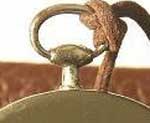 |
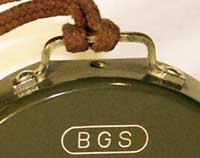 BGS = Bundesgrenzschutz = former West-German border police, since the reunification: Bundespolizei |
| View of the
older issue of the first FLUID DAMPENED Bézard dismantled: the
case bottom was cut away and a thn aluminum disk protected the capsule.
The mirror was chromated. |
The 360°
graduation (s.
image below)was covered with a paper stripe printed with
(64oo) mills divisions. The cardinal points NW, N and NO were marked
with a luminous material (paper?). There was no letter for North but
only a small arrow located 5° W which is consistent with the
declination in the 1950's.
  |
Adjustable distance measuring
device in the lid instead of the usual arrow: the calibrated
distance for a short number of steps was used to calculate longer
distances. (Click on the images for enlarged views) |
 |
 View from below of the transparent capsule |
The first version of the liquid
damped Bézard's with the classical stripe (ORIGINAL BÉZARD in black
letters on white ground) and a new red-and-white WILKIE-type needle (Pictures sent by a priv. collector) |
 Simple civil version: The metallic case and lid were coated with verdigris enamel. In the FLUID UBK (pic on the right), the words FLUID BEZARD and the lines were white. |
This model with steel lid weighs almost 5 oz. (150 gr). There was also a light-weight version (3 oz./100gr) painted in dark brown and with an array of red lines and an arrow on the capsule's bottom (picture HERE). |
 Wrist Fluid-Bézard model "Bw" (Bundeswehr / Armed Forces of the Federal Republic of Germany). This one also existed in a version with red lines and an arrow on the capsule's bottom. CHECK OUR ÉZARD ENTRY IN WRIST COMPASSES (Picture Ted Brink) |
The oldest: Black, ribbed, edge-to-edge stitching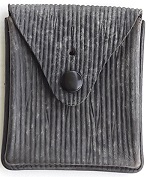 |
Designation
Type 1910 in golden letters or imprinted  Pictures by courtesy of
SWGR-O.P.Lang
|
 TRENCH
ART TRENCH
ARTPouch made of the typical "grey" linen (three-colour thread) used by the Imperial Austrian Army with a collar sign of the machine gun sections sewn on top. Picture by courtesy Salzburger Wehrgeschichtliche Rainerforschung |
Brown, smooth leather, corner stitching |
Probably the last but one version: brown lacquer
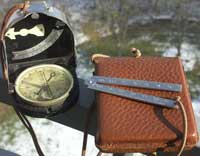 |
Luxurious velvet-lined version made for the Bundeswehr (BUND) |
BUND
- In West Germany,
the lid bore the wording BUND (Federation) in the
BUNDESWEHR (German Federal Republican Army) and BGS
in the border surveillance units (BUNDESGRENZSCHUTZ) now renamed the
Federal Police (Bundespolizei).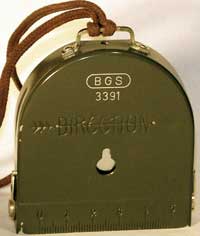 |
Graduation of the Army
(BUND) and the BGS compass: 6400 mils.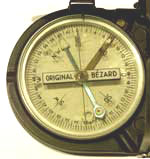 The Bundeswehr had FLUID BEZARD models. The declination (3° W) was taken into account but not adjustable! |
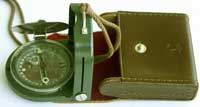 The Fluid Bézard no longer had fittings for the ruler. 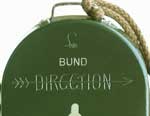 See also the user instructions and training material We have no precise information concerning the period during which the Army and the BGS had these compasses. Your help is needed. |
| FRANCE
(Armée Française, AF / French Army) The UBK Export model was also used but unpainted. See box label below. 
 |
The AF
Bézard compass was
issued with 360 degrees and 6400 mils divisions (pic r.:
UBK).
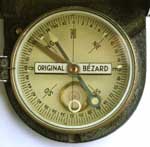 |
Equipment for the French
troops in Indo-China and
Algeria (1946-1954 and 1957–1962 conflicts). COMMENT : It would be interesting to know if France sourced these compasses from LUFFT under extremely advantageous commercial conditions after the Second World War (as a payment for destructions during the War?). That would have been the final blow to the compass industry in France. On the other side, a comparison of the 1922 model with the Bézard shows that technologically it was obviously no match. |
| ITALY The compass and the cardinals are identical to the French civilian version. Two issues of the manual are known: 1930s and 1950s (photocopies of the latter are available). |

Early version |
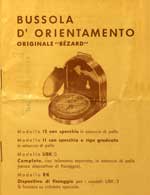 Late version |

| BRAZIL: DIREÇĂO Brazil's armed forces (FORÇA EXPEDICIONÁRIA BRASILEIRA) were issued a UBK model with 360 deg. divisions but w/o level. Abbrev. under the coat of arms: M. G. = Ministerio de Guerra (War Department). Brazil's coat-of-arms punched in the lid (compare with the official drawing at right) Pic. left courtesy I. R. Ferreiro Pinto / Pic. right: small model, 6400 mils. counter clockwise, Portugal (Click on images for enlarged views) |
On the case reverse: the conversion table and the manufacturer's name LUTZ FERRANDO / Rio - Sao Paulo. We suppose that this instrument was partly made under license: LUFFT shipped unfinished parts to LUTZ who punched his data and assembled them. | The
serial no. punched on the base: The letter L stands for the manufacturer's name. |
| EXPORT
VERSIONS of the UBK model The standard export version featured cardinals in English (link to pic.). The item below probably belonged to a very small series for Spanish-speaking languages. The UBK apparently didn't sell well abroad and this particular compass features several errors. Engraved on the lid is the usual DIRECTION marking.  |
The cardinal point for West (oeste
in Spanish) ist is abbreviated OE (click on images for enlarged
views) Note: the table is written in French but with several errors (s. pic at r.). The two words "Tableau comparative" should read Tableau comparatif (wrong ending) but it would be false all the same. Such table are called in French Table de conversion or d'équivalence. Furthermore, the German word for MILS Strich (right column, compare to the German version: Str.) was translated with "gr" (for grade) instead of mill. (milličmes) which is a totally different unit! |
Engraving
on the mirror's reverse: "Made in Germany" Below: the table with the translation errors |
ROMANIA:
DIRECŢIA . .There were two different models: one engraved "Original-Bézard" on the case underside, the other one "Busola-Bézard":  Both versions featured a military graduation (6400 Mils). The cardinals are indicated in Romanian language: (Click for enlarged view)
|
TURKEY
(1930's) Interesting note about the language: See Miscellaneous/ Cardinals/ Turkey This item was donated to Compassipedia by Doug Carter |
SWEDEN (1930's) Picture courtesy McCaughan Divisions: 63oo Mils, counter clockwise, card. in German (read in menue / Miscell. / Divisions MILS - 63oo) On the case: LUFFT's two logos (see next row Czechosl.)  |
| POLAND After a first version marked PATENT, the word ORIGINAL was written in Polish language: ORYGINALNY   |
YUGOSLAVIA
(Serbo-Croatian. - see menue Miscell. / card. points):  |
ESTONIA (German)
Stamp of the Tallinn Arsenal on the lid. The
figure 6400 appears in addition below the zero. |
| CZECHOSLOVAKIA (1920's
and 30's): Armeemodell I, 360 deg. counter clockwise  |
The
cardinal points are identical to the ones in Yugoslavian language
(above) Pictures at right: Version with several logos Left: Czechoslovakia's coat-of-arms (heraldic lion in a square standing on one corner) between military units' numbers (P.18.7 ... 23) Right: LUFFT's logo above a flat cylinder (barometer capsule) |
  |
NETHERLANDS
("RICHTING") Old army models were marked
either D.v.O. (Dept. van Oorlog =
War Dept.) until 1928 when the name was changed to DvD (Dept. van
Defensie). The Army compass was called M.22 (model 1922) Old army models were marked
either D.v.O. (Dept. van Oorlog =
War Dept.) until 1928 when the name was changed to DvD (Dept. van
Defensie). The Army compass was called M.22 (model 1922) |
The German word RICHTUNG
(DIRECTION) was translated into Dutch RICHTING:  (Click on images for enlarged views) |
Post
WWII issue (1960?): ORIGINEEL instead of ORIGINAL BÉZARD 
|
NETHERLANDS: Licensed production
(?) by BECKERS' SONS (link to the company's main entry and
profile HERE) |
Beckers'
Sons later version without marking of the Ministry of Defense |
 The French catalogue |
| DENMARK Manufacturer: Cornelius Knudsen - Kiřbenhavn (Copenhagen) Famous Danish marine optician. Compare with the Dutch item (bottom) 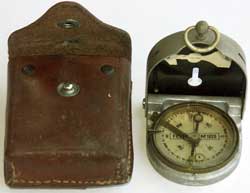 |
DESCRIPTION - Dimensions:
same as small model I (no mirror). Graduations: 6400 mils,
counterclockwise. Full figures are written with 4 digits (1000, 2000
etc.). Cardinal points in German. No. 1323. No ruler at the lid's
basis. The word RETNING
(direction) is written with the same fonts than on the original German
Bézard compasses. The manufacturer's name indicated on the case
underside encompasses a coat-of-arms topped by a crown and displaying a
pair of drawing compasses and a drawing square. The label on the
West-East axis reads: FELTK. / M. 1928 (field compass / Model 1928). The crown and the letters HV (Hćrens Vĺbenarsenal) mean Royal army weapon arsenal. Between 1928 and 1932, this abbrev. changed to HT (Hćrens Třjhus = army arsenal). 
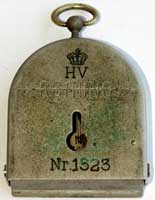 
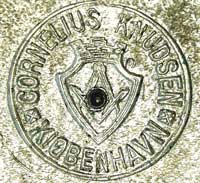 |
| GERMANY (East,
former GDR) Manufacturer: FPM (Freiberger Präzisionsmechanik) (Read more details in the category Marching compasses) |
|
| FRANCE Manufacturer: J. Auricoste (Read more details in the category Marching Compasses) |

|
Manufacturer: CHAIX (Read more details in the category Survey Compasses) |

|
POLAND |
 |

Maker: Stefan Józefowicz, located in Milanówek |
Technical Data The words NAPIS NA MAPIE mean : Inscription on map Ruler: 6 cm / Width: 8 cm. The capsule's bezel is located below the casing. An additional rear sight and two holes in the mirror make the sighting more precise. |
| RUSSIA
(former USSR)
UBK model made by ФИЗЭЛЕКРОПРИБОР (fizelektropribor) of Moscow (link to pic. of the maker's logo imprinted on the glass) probably made in the 1930s or later, after Hitler and Stalin signed a non-agression pact. It features cardinals in cyrillic letters (C = north) and is divided in 6000 mills according to the system of the former Warsow Pact. Additional luminous dots at 45° left and right of north as on the German Wehrmacht compasses. No marking on the lid like DIRECTION.The very tiny original screws securing the capsule in the casing from the side have been replaced by larger screws accessible from above which hold tabs protruding into the groove in the capsule which can be oiled via a dedicated grease hole without dismantling. The case has an opening for the level but it is closed by a blind plate. |
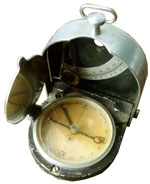 |

|
 The clinometer scale  Logo of ФИЗЭЛЕКРОПРИБОР |
| CZECHOSLOVAKIA
- 1 Civilan models (360 deg.) in different versions signed Optikotechna (logo: a T in a circle, German markings), SŠP and MEOPTA (for full description pls. follow the links). There was also a military version (64oo MILS) on which the word SMĚR (direction) was engraved inside and outside the lid. |
Military version (Click on the image for a view of both faces) |
ŠP's
logo
|

 Logos of Optikotechna and MEOPTA |
| CZECHOSLOVAKIA
- 2 Maker is Optikotechna - see logo "T in a circle. The word "SMĚR means DIRECTION. Compass equipped with a mirror that could be pivoted over 180 degrees: 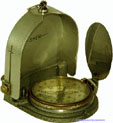 (Click on the picture for viewing a movie showing the mirror's rotation) |
(Click
on the picture below for an enlarged view)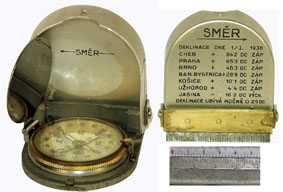 |
The outside of the lid bears declination values for
cities to the East and to the West, from the German border (Cheb /
Eger) to the Ukrainian border (JASINA) passing through Prague (PRAHA)
valid for the year 1938. The ruler allowed the direct reading of distances on military maps to 1:75 000 - one division measures 1,33 mm equivalent to 100 metres on the ground. The lid is also equipped with a metal support undoubtedly for use on field guns. Technical Data - Divisions : 6400 mils - Diameter: 45 mm - Weight: 145 g - Dial (for picture, click on link): 6400 mils., clockwise |
| ROMANIA Manufacturer: I.O.R. Read in the category Marching Compasses details concerning this company. |
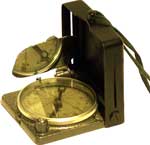 |
| NETHERLANDS Manufacturer: unknown The case ist almost identical with the Danish version above. LUFFT probably exported unsigned instruments. |
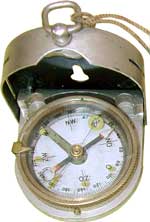 Picture by courtesy of Snyder's Treasures |
HUNGARY:
IRÁNY (DIRECTION) The oldest small version that we know of was built by GAMMA. The large military version (from 1930 on until post WWII) was made by SÜSS - MOM / Süss Nándor also called Plant No. 41 for reasons of secrecy. (Click on the links to jump to these entries) |
Pictures (left and
center): MOM / 41 - (right): GAMMA

 |